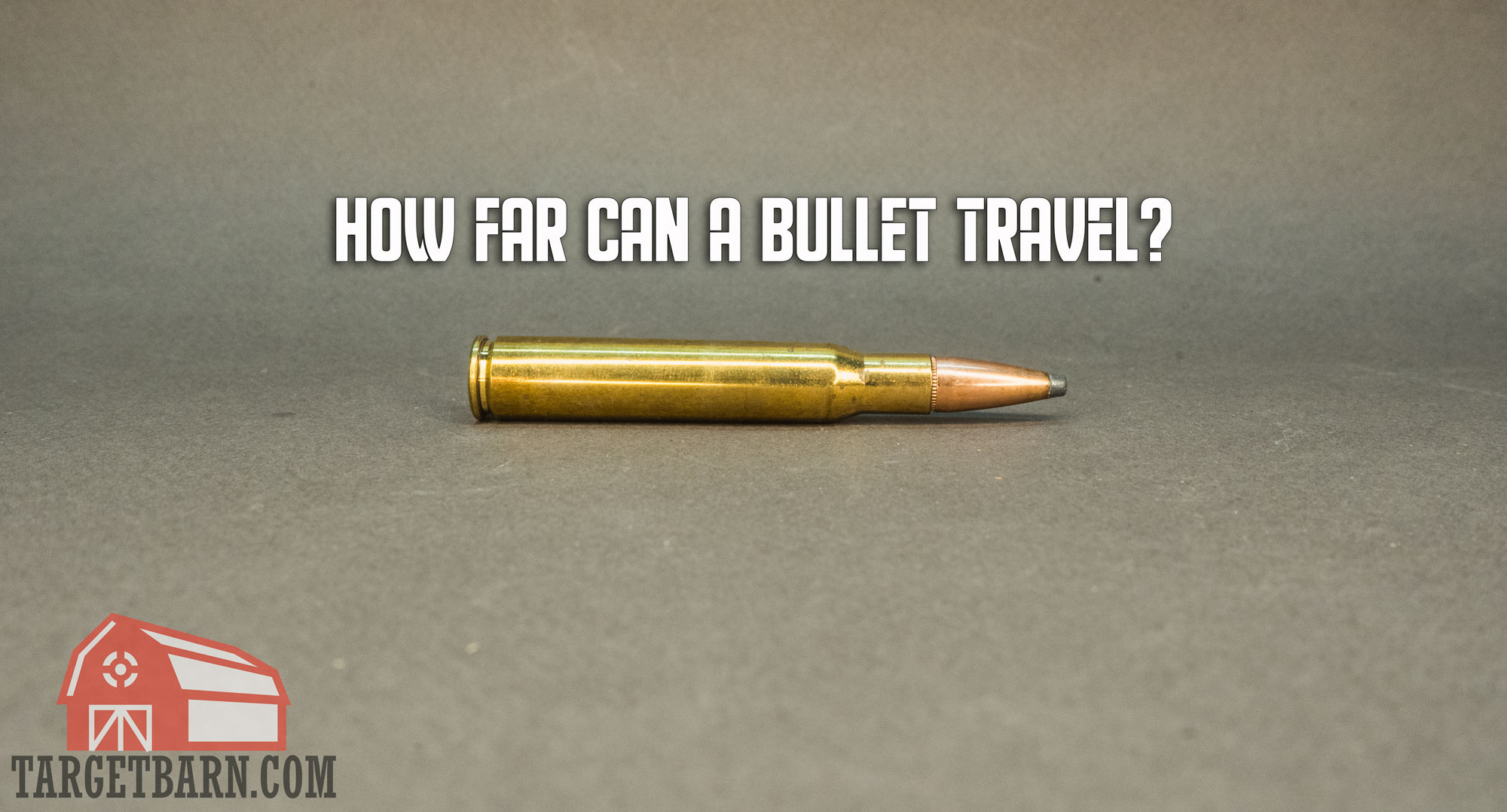What is the maximum range of a .223 bullet? A .223 bullet can travel a maximum distance of around 3,600 meters (approximately 3,937 yards or 2.24 miles) under ideal conditions. However, the effective range for accurate targeting and ethical hunting is significantly shorter. This article delves into the ballistics of the .223 cartridge, exploring its range, trajectory, and vital safety precautions.

Image Source: blogcdn.targetbarn.com
The Science of .223 Ballistics
The .223 Remington (also commonly known as the 5.56 NATO when loaded to military specifications) is a popular cartridge known for its versatility and widespread use in sporting rifles like the AR-15. To truly grasp how far a .223 bullet will travel, it’s crucial to look at the complex world of ballistics.
Internal Ballistics
This covers what happens inside the gun when it’s fired.
- Pressure: When the firing pin hits the primer, it ignites the powder. This creates gas and pressure.
- Acceleration: The gas pushes the bullet down the barrel, making it go faster and faster.
- Barrel Length: A longer barrel usually means the bullet can go faster because it has more time to speed up.
External Ballistics
This focuses on the bullet’s flight after it leaves the barrel.
- Gravity: The force pulling the bullet back down to earth.
- Air Resistance (Drag): Air slows the bullet down as it flies. The bullet’s shape affects how much air slows it down.
- Wind: Wind can push the bullet off course. How much depends on the wind’s speed and direction.
- Spin: Rifling in the barrel makes the bullet spin. This spin helps keep the bullet stable and flying straight.
Terminal Ballistics
Terminal ballistics describes what happens when the bullet hits a target.
- Energy Transfer: The bullet gives its energy to the target. This can cause damage.
- Penetration: How deep the bullet goes into the target. This depends on the bullet’s speed, shape, and what the target is made of.
- Fragmentation/Expansion: Some bullets break apart (fragment) or get bigger (expand) when they hit something. This can cause more damage.
Dissecting the .223 Bullet Range
The .223 bullet range can be discussed in different contexts: maximum, effective, and lethal.
.223 Maximum Distance
The .223 maximum distance, also called the absolute range, is how far the bullet will travel if fired at an optimum angle (typically around 45 degrees) in a controlled environment. As mentioned, this can be up to 3,600 meters (approximately 3,937 yards or 2.24 miles). Keep in mind that at this range, the bullet has very little energy and is highly susceptible to wind. It is extremely dangerous and irresponsible to fire a weapon without knowing what lies beyond the target and without being absolutely certain of a safe backstop.
.223 Effective Range
The .223 effective range is the distance at which the bullet can consistently and accurately hit a target while still delivering sufficient energy to cause the desired effect. This is much shorter than the maximum range.
- For military applications (5.56 NATO range), the 5.56 maximum effective range against a point target (like a person) is generally considered to be around 500-600 meters.
- For hunting, the effective range depends on the size of the game and the hunter’s skill. Generally, a .223 is considered effective on small to medium-sized game at ranges of up to 200-300 yards.
.223 Lethal Range
The .223 lethal range is difficult to define precisely. Even at long distances, a .223 bullet can cause serious injury or death. While the energy of the bullet decreases with distance, it can still penetrate skin and cause damage to internal organs. This reinforces the critical importance of safe gun handling and awareness of what lies beyond your target, even at extreme distances.
Factors Influencing .223 Ballistics
Several factors impact the .223 trajectory and overall performance:
Ammunition Type
Different bullet weights and designs will affect the range and trajectory.
- Bullet Weight: Heavier bullets tend to retain energy better at longer ranges but may have a more curved trajectory. Lighter bullets are faster initially but lose energy more quickly. Common bullet weights for .223 include 55 grain, 62 grain, and 77 grain.
- Bullet Shape: Streamlined bullets with a high ballistic coefficient (BC) experience less drag and maintain velocity better.
- Powder Load: The amount and type of powder affect the bullet’s initial velocity and, consequently, its range.
Barrel Length
A longer barrel allows for more complete powder combustion, resulting in higher velocities. Shorter barrels result in lower velocities and decreased range.
Environmental Conditions
- Wind: Wind speed and direction significantly impact the bullet’s path.
- Temperature: Temperature affects air density and powder performance, which can influence velocity and trajectory.
- Altitude: Higher altitudes have less air resistance, potentially increasing range.
- Humidity: Humidity can slightly affect air density, but the impact is usually minimal compared to other factors.
Rifle Setup
- Optics: A quality optic is crucial for accurate shooting at longer ranges.
- Rifle Twist Rate: The twist rate of the barrel affects the bullet’s stability in flight. A faster twist rate (e.g., 1:7) is generally better for stabilizing heavier bullets.
The .223 Trajectory and .223 Bullet Drop
The .223 trajectory is the path the bullet takes from the muzzle to the target. Due to gravity, the bullet begins to drop as soon as it leaves the barrel. This drop becomes more pronounced at longer ranges.
.223 bullet drop refers to the vertical distance the bullet falls below the line of sight at a given range. This drop must be accounted for when aiming at targets at varying distances. Ballistic charts and ballistic calculators can help predict bullet drop for specific ammunition and environmental conditions.
Here’s a simplified example of .223 bullet drop (using a 55-grain bullet at 3,100 fps, zeroed at 100 yards):
| Range (Yards) | Bullet Drop (Inches) |
|---|---|
| 100 | 0 |
| 200 | -2.5 |
| 300 | -9.5 |
| 400 | -22.5 |
| 500 | -42.5 |
Note: This is an approximate example, and actual bullet drop will vary depending on the specific ammunition and conditions.
Safety Tips for .223 Rifles
Safe gun handling is paramount, regardless of the cartridge. Because of the .223’s extended range capabilities, the following safety precautions are especially critical:
- Always Treat Every Firearm as if it is Loaded: Never assume a gun is unloaded.
- Never Point the Muzzle at Anything You are Not Willing to Destroy: This is a fundamental rule of gun safety.
- Keep Your Finger Off the Trigger Until You are Ready to Shoot: This prevents accidental discharges.
- Be Sure of Your Target and What is Beyond It: This is crucial for preventing unintended harm, especially with a cartridge like the .223 that can travel a long distance.
- Use Appropriate Ammunition: Only use ammunition that is specifically designed for your firearm.
- Wear Eye and Ear Protection: Shooting glasses and earplugs or earmuffs are essential for protecting your senses.
- Store Firearms Securely: Keep firearms locked up and out of reach of children and unauthorized individuals.
- Know the Laws: Be familiar with all local, state, and federal laws regarding firearm ownership and use.
- Never Consume Alcohol or Drugs Before or While Shooting: This can impair your judgment and reflexes.
- Regularly Maintain Your Firearm: A clean and well-maintained firearm is a safer firearm.
Selecting the Right Ammunition
Choosing the right .223 ammunition depends on your intended use.
- Target Shooting: Lighter bullets (55-grain) are often preferred for their higher velocity and flatter trajectory at shorter ranges.
- Hunting: Heavier bullets (62-grain or 77-grain) offer better penetration and energy transfer for hunting small to medium-sized game. Be sure to check local regulations regarding the legality of using .223 for hunting specific species.
- Self-Defense: Ammunition designed for self-defense typically features expanding bullets that maximize energy transfer and create a larger wound cavity.
The 5.56 NATO vs. .223 Remington
The 5.56 NATO and .223 Remington are often used interchangeably, but there are some important differences. 5.56 NATO is typically loaded to higher pressures than .223 Remington. While a rifle chambered in 5.56 NATO can safely fire .223 Remington ammunition, it is generally not recommended to fire 5.56 NATO ammunition in a rifle chambered in .223 Remington, as the higher pressures could damage the firearm or cause injury. Always consult your firearm’s manufacturer’s recommendations regarding acceptable ammunition types.
Final Thoughts
The .223 Remington is a versatile cartridge with a maximum range of approximately 3,600 meters. However, its effective range is significantly shorter and depends on factors such as ammunition type, barrel length, environmental conditions, and shooter skill. Safe gun handling is paramount, and it is essential to be aware of the potential for long-range impacts when using this cartridge. Always prioritize safety, know your target and what lies beyond it, and use appropriate ammunition for your firearm and intended purpose. A thorough grasp of the .223’s ballistics empowers responsible firearm ownership and ensures safety for yourself and others.
Frequently Asked Questions (FAQ)
Q: What is the maximum range of a .223 bullet in miles?
A: The maximum range is approximately 2.24 miles.
Q: What is the effective range of a .223 for hunting deer?
A: While a .223 can be used for deer hunting in some jurisdictions, it is generally considered underpowered for ethically harvesting deer at longer ranges. If it is legal in your area, keep shots very close and use premium ammunition specifically designed for deer hunting. A more powerful cartridge is generally recommended for ethical deer hunting.
Q: Can a .223 bullet travel through walls?
A: Yes, a .223 bullet can easily penetrate drywall and other common building materials. This is another reason why knowing your backstop is essential.
Q: Does temperature affect .223 ballistics?
A: Yes, temperature can affect powder performance and air density, which can influence velocity and trajectory.
Q: What is the best twist rate for a .223 rifle?
A: The best twist rate depends on the bullet weight you plan to use. A 1:9 twist rate is a good all-around option, while a 1:7 twist rate is better for stabilizing heavier bullets (62-grain and up).
Q: How important is knowing the .223 bullet drop?
A: Knowing the .223 bullet drop is very important for accurate shooting at longer ranges. Without accounting for bullet drop, you will likely shoot high or low of your intended target.

Hi, I’m Candace Wafford, a travel and food blogger based in Lexington, Kentucky. As a corporate traveler, I’ve had the chance to explore a lot of places, but now I’m on a mission to travel full-time. My goal? To figure out how to take my cat along for the adventure! Here at destinationdorworth.com, I share my experiences and tips on outdoor activities, travel, and of course, the best food spots I come across. I hope my blog inspires you to explore more and eat well on your journeys!
